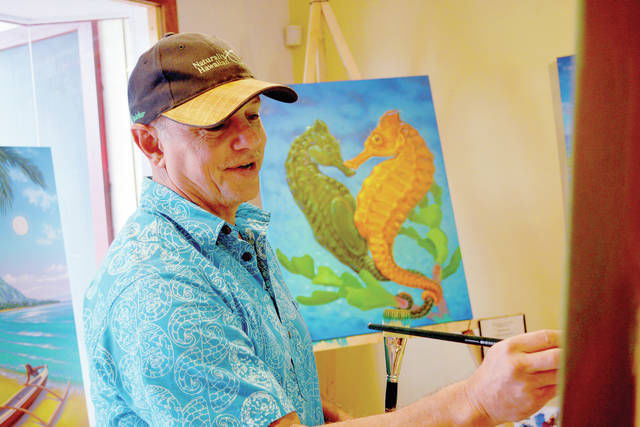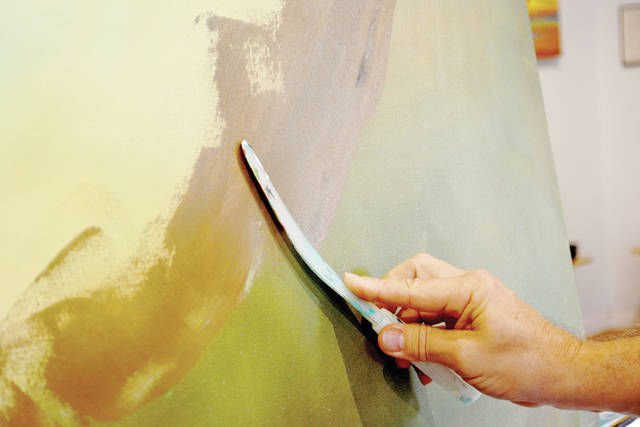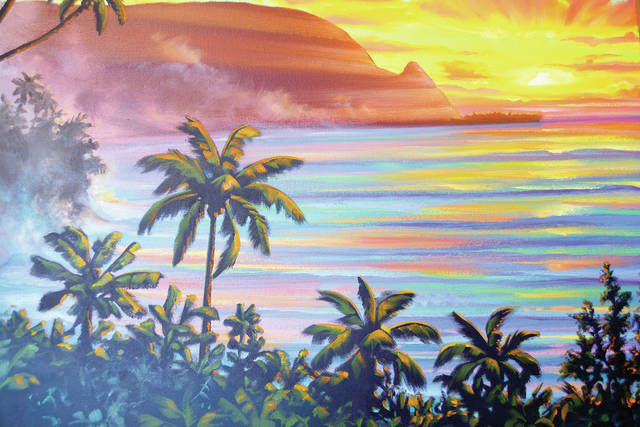The Ching Young Store is playing host to Patrick Ching’s fifth annual Kai Ocean Art Show until Saturday. The show opened Feb. 18 and Ching paints in the space while patrons filter in and out. He also livestreams painting sessions
The Ching Young Store is playing host to Patrick Ching’s fifth annual Kai Ocean Art Show until Saturday.
The show opened Feb. 18 and Ching paints in the space while patrons filter in and out. He also livestreams painting sessions on social media.
Ching spends about eight hours a day painting in the space and has transformed it into a creative haven where anyone can pick up a paintbrush and put their own touches on one of 10 oil paintings that are in the works.
TGI stopped by the Kai Ocean Art Show on a sunny Hanalei morning to chat painting with Ching and see the progress of the art show, which is a benefit for the Kilauea Point Natural History Association, the educational nonprofit organization connected to the Kilauea Point Lighthouse.
How did the Kai Ocean Art Show get started?
I wanted to do a unique type of show and it started in 2013, that was the first one. Basically the thing is, we look for an open space to put love in, usually a place that’s in between tenants. I rent the space out and it gets a lot of activity and then usually the space gets rented out. We started at Princeville Center with a place that was not rented.
I never know where the show is going to be until the week before because they’re trying to rent it out. After one month of us getting a lot of people in here, you rent it out after that.
How does it generate money for the Kilauea Point Natural History Association?
This show has always been a benefit for the Kilauea Point National History Association. People bid on the paintings as we’re doing them and we ship them out at the end.
This show was their (Kilauea Point Natural History Association) biggest donor last year for sure. They get thousands of dollars from the show.
A lot of times, the people that have bid on it do that because their family and kids have worked on it.
We entice the first bidders with big canvas reproductions, so they’re getting a $675 size giclee, even if they get outbid they get a free giclee. We really do it up for the first bidders because once a painting has a first bid, it has a home. We give a lot of art away at the end of the show.
In the beginning though, they’re bidding on faith, but I put my whole heart into making these paintings come out as nice as they can and they’re always happy with them.
What’s your favorite part about putting on the Kai Ocean Art Show?
It’s always been community participation and that’s always a fun part about it, plus it’s the kind of show you can take anywhere in the country. It’s a really, really great working model.
Who has been contributing to the paintings so far in this show?
This year we’ve had homeschool groups and of course all the visitors and their children put their love in the painting, even parents holding babies. Each of the paintings got the mana from the community — people that work here, people that do the art classes, and people walking by.
For most of the paintings, I just need the paint down on the canvas, it’s not critical where they put their brush strokes, I can push it around where I want.
The thrill they get from contributing to a professional quality painting it makes their day, and ours too.
I’ve got 10 paintings under way, all in different stages and I’m using oil paint, so it’ll stay wet all day. In that time, I’ve got nine other paintings to go paint. There’s only one so far I’ve finished.
What inspires you to paint animals and settings from nature?
I’m from here and I’ve been here all my life, so I specialize in native animals but animals is what got me to learn as a kid. I was such a poor reader, I was embarrassed trying to read in class when everybody else was reading around me, but when I found a frog or catfish I ran to the encyclopedia and looked it up. That’s how I got excited about reading, I liked animals.
I’ve been here my whole life so that’s all I really knew, I definitely have been concentrating on native animals but I’m looking forward to seeing the rest of the world and exploring and traveling.
How did your time working at Kilauea Point National Wildlife Refuge influence your art?
I did get to live there almost 10 years in the lighthouse keepers houses, and I got to see some dreams come true in those times. When I moved there nobody ever saw monk seals around Kauai or the main islands. That was in ‘84 or ’85.
Then we saw the monk seals coming down the chain, Niihau. Going to the beach and seeing a monk seal was never a reality for me growing up, it was like seeing a mermaid.
Then, I got to spend a lot of time in the Northwest Hawaiian Islands in the summer. I’d live and work in the Northwest Hawaiian islands, and I thought of the animals as my family.
The iwa bird, the frigate bird were right outside the window of the tent. The monk seals are trying to roll under the tent, and in the ocean, you’d go out to wash your dishes and there’s sharks all over the place.
I remember one day, I was on Laysan Island, I went for a little swim and sharks started to circle me. Soon there were six sharks, and then 10, and soon I was surrounded by all these sharks in circles, circling me both directions. I just told myself, “You stay calm and keep your heartbeat down.” There I went from fear to amazement at the beauty of the shark and from that day on, I was such a fan of sharks.
Really my big idea when I’m painting is that hardly anybody will be able to see this stuff live in their lifetime, they might see it on a video or in a book, but to have it in their home, it puts it in their consciousness.
What are your other inspirations and aspirations, as an artist?
I like to create paintings that people have around them and make them feel good. I paint for the viewer’s subconscious mind. I put caring about nature and wildlife in their consciousness.
If it makes you feel good, it’s making everyone else around you feel good and it’s good for everybody. That’s what the artist’s role in the community is, to get people excited about being creative and making the community healthier.




